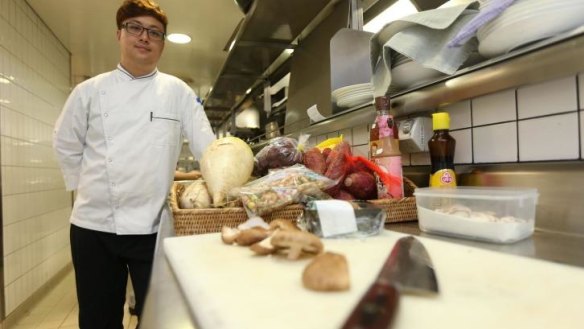Good Food Month: Tantalising taste of life from North Korea

In a quaint corner of a Potts Point retail strip diners this month undertook a gastro-journey into the reclusive and hostile country of North Korea.
At Kim Restaurant 40 diners tucked into a five-course banquet focusing on a style of Korean food developed in a sealed-off world, most likely enjoyed just by Pyongyang's elite.
The fact most North Koreans are impoverished and oppressed under Kim Jong-un's brutal regime was not lost on chefs David Ralph and Tae Kyu Lee.
"We were very mindful of the extreme hardships and the extreme poverty in North Korea but we didn't want to get political because the focus was educating people about Korean food," said Ralph.
Distinct from Kim's regular menu of South Korean classics with an Australian twist, Ralph and Lee served dishes such as fermented fish with garlic and chilli, called sikhae, and poached baby chicken in chilled vinegar and mustard, called chogyetang.
"There's less chilli compared to South Korean cuisine and it's more reliant on starch because of their harsh winters," he said.
The growing appetite for Korean food in Sydney, spurred by the launch of Moon Park in Redfern and Danjee in the CBD this year, has Korean chefs itching to demonstrate the depth and breadth of the cuisine.
Ralph said the Journey to the Forbidden Kingdom banquet was the first in a series of regional Korean dinners celebrating the diversity of the cuisine. In February, they will shift their focus to the food of South Korea's coastal city Busan.
On Wednesday Dong Lee, the sous chef at Bathers' Pavilion in Mosman, will replace the forks with chopsticks and host a Korean feast infused with the flavours of his childhood for Good Food Month.
Lee, born and raised in Ulsan, near Busan, will plate up national staples such as braised beef ribs, called galbijjim.
"Many Koreans make galbijjim with potatoes but I like how my mum uses radishes instead because it creates a cleaner, clearer flavour," he said.
He will also inject Australian ingredients into traditional recipes using almonds, for example, in a chilled noodle dish usually prepared with soybeans. The dinner will close with a mix of persimmon-based desserts.
"Where I grew up there were persimmon trees everywhere. The flavour brings back so many memories," he said. "My grandmother would put a spoonful in my mouth when I was a baby to make me stop crying."
The dinner, of course, would not be complete without ample servings of Korea's pride and joy kimchi, the spicy fermented cabbage side dish.
Heather Jeong, a Sydney chef born in Seoul, said she can make a solid guess about which province a family hails from by the saltiness, spiciness and fishiness of their kimchi.
When she opens her restaurant Moko
"I want to explore more regional food, food that's never been seen in a restaurant here, like bindae tteok (mungbean pancakes)," she said. "I also want to do ogingeo sundae (stuffed squid). There's a region so famous for all their squid dishes and I want to show that."